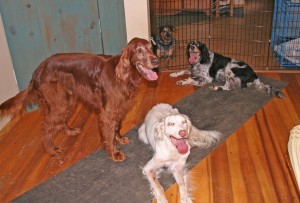Do you need toys? No, not the toys you played with when you were a child. But grown up ‘toys’. There are so many examples and each person views different things as entertainment and enjoyment aids. Things such as sports equipment, books, music, TV, video games, exercise equipment, etc. I could name hundreds of items that different humans view as their version of toys. Most people have both active and passive ‘toys’. Some ‘toys’ physically tire us out. Some ‘toys’ mentally tire us out. Both have their place and both are necessities.
Everyone unwinds in different ways. Dogs are like that too. One dog may enjoy a good chew on an antler to unwind after dinner. Another dog may enjoy racing around the house after a ball. Yet another may view stuffed toys as calming and self-soothing.
Where it gets complicated in some multiple dog households is when there is some resource guarding that has gone unchecked. I have been to homes where things have progressed to the point that all of the toys were removed. Ponder the significance of that statement and apply it to your own life. Wow, powerful thought, isn’t it? How would do you deal with that? Would your sanity be in danger with no recreational outlet? I know mine would. Now why would it be any different for your dogs? Everyone needs environmental enrichment. This is crucial for mental stability.

All dogs like toys of one type or another.
It’s even worse for dogs who have never had toys or have had them taken away early in life. The reasons often vary. They range from pulling all of the stuffing out of stuffed toys to eating a Kong and needing surgery. These are remedied in different ways but are not a reason to eliminate toys on a permanent basis.
Stuffed toys: it’s fun for a dog to pull out the stuffing. As long as they are not ingesting said stuffing, simply buy very inexpensive dollar store stuffed toys and supervise. Let them have a blast. Get over the clean up factor. It’s not the end of the world to pick up toy stuffing. If they are pulling out the stuffing in order to get to the squeaker, there is a line of stuffed toys called Egg Babies that have stuffed eggs in the pocket of a stuffed toy that allows the dog to pull the squeaker out without damaging the toy. It usually takes only a moment for a dog to understand this concept once shown. My own beloved Merlin adored his Platypus Egg Baby. It was the only toy he did not disembowel!
Sucky toys: my Kenzo loves to suck on his tuggy toys. This relaxes him. Some dogs like to knead and suck on pillow type toys or even throw pillows. Any Doberman that I have ever shared my life with has done this. Again, thrift stores/low cost options are your friends here. And supervise.
Antlers: some dogs love them, some can take them or leave them. Dogs that like harder chew things like deer antlers, dogs that like softer things often prefer elk antlers. There also now are hollow horns available that are yet even softer than antlers. Know your dog’s chewing style. If their goal is to break the antlers, then these are not the right chew things for them.
Nylabones and the like: again, some dogs love them, some dogs can’t be bothered. Most dogs like the Nylabone Galileo and Benebones of some sort. Just don’t step on them in the middle of the night or drop them on your foot. Ouch! Size these toys appropriately for your dog.
Kongs and other food dispensing toys: choose the hardiness appropriate for your dog. If he can’t have a Kong goodie bone because he may break it in half, then get the larger Kong products. There are so many to choose from that there is bound to be one appropriate for your dogs.
Sturdy toys for destroyer dogs: I get so many people saying their dogs destroy everything and no toy is safe so they stop buying toys. Nonsense. I have found Cane Corso proofed toys. If they can’t destroy these toys, neither can your dog. Try them. Your dog will thank you. There are several among the tried and tested options. Jolly Balls, Orbee balls, Kong Wubba, the aforementioned Nylabone Galileo and now Bully Make products. Again, size appropriately.
Now for the more challenging equation. Multiple dog households with a resource guarder or two. Number one, get in-home professional behavior assistance. Run, don’t walk, to your search engine and find a qualified one in your area. Email me and I will find you one. Your dog’s sanity depends on it. They need toys. In the meantime, set up sturdy tethers with the guarders in question, out of reach of one another and give them something to help them relax. Or crate them for this activity on a regular basis. I prefer tethers as they learn to do this in proximity to one another without making poor choices. You can also spend separate time with each playing with active toys. It’s THAT important.
Some of you may be thinking that your dog doesn’t like any toys. Again, nonsense. You just haven’t found the kind they like yet. Even if the only thing they end up liking is gnawing on a marrow bone, that is better than no toys at all. And toys don’t have to be actual toys. Plenty of dogs like to simply carry something around and not actually play with it. Some dogs like to play with empty plastic soda bottles and nothing else. Some dogs just want to run around the house. This is still play. And sometimes you have to teach a dog that it can be fun to play with toys. That usually starts with food but it’s not always necessary.
A word about exceptions to the playing requirement. Often when dogs get older, they grow less interested in play. That is normal but they still typically view something as relaxation. My Siri is twelve now (when this was written many years ago) and she occasionally still ‘beats up on’ Kenzo for fun but she always carries her huge furry ball around in her mouth. Mela carried on the stuffed ball tradition on after Siri. Other exceptions are dogs that are simply finding their own peace sniffing on their walks. That is great.
The stressed dogs I am talking about have little in the way in mental stimulation. If you walk your dogs daily and they have toys available to them but don’t play with them much, then don’t worry. But if they get neither walks (that are calming because reactive dog walks are NOT calming!) or toys, then you very likely have a problem. So allow your dogs toys. Teach them if you have to. I guarantee you that once you engage your dog(s) with toys, you will have a much happier and more mentally stable dog than you had before. Try it. There is joy in play and relaxation time. Allow your dogs that joy.
Tags: behavior, chew, dog, dogs, household, impulse control, kong, manners, many, mental, multiple, positive, relaxation, resource guarding, shelter, squeaker, stress, stuffed, toys, train, training, tug toys, unwind
Posted in: Projects




















